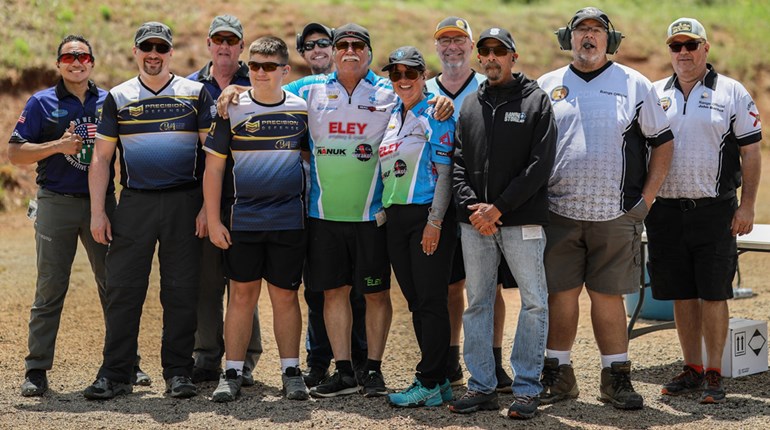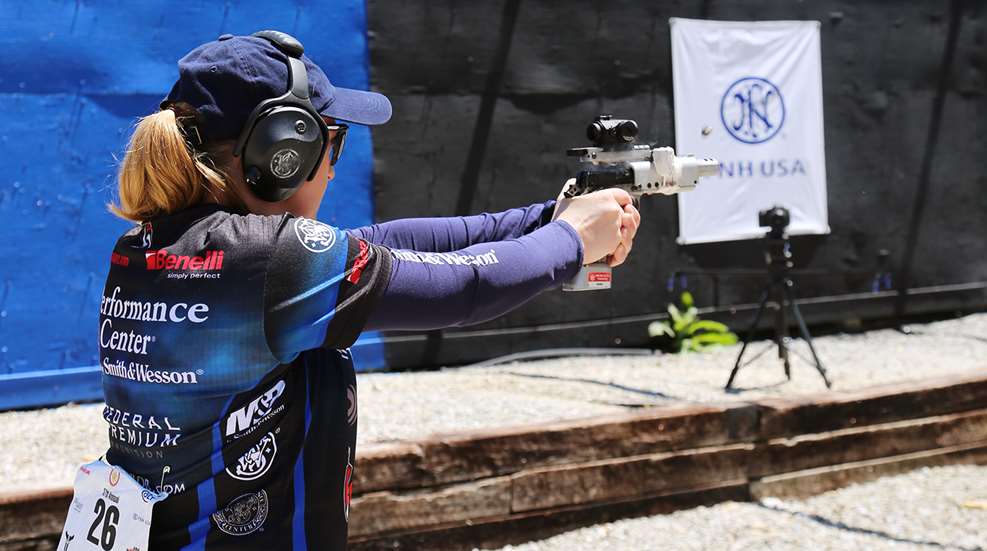
In a social media landscape that inundates competitors looking for daily news and information, Smith & Wesson Team Captain Julie Golob sets the standard in utilizing the medium for one simple task: Sharing her love of competitive shooting to friends and followers alike.
Over the last decade, social media has matured from its beginnings with Friendster and MySpace into the myriad of platforms that are available today. People around the world—including competitive shooters—can instantly connect with their like-minded counterparts.
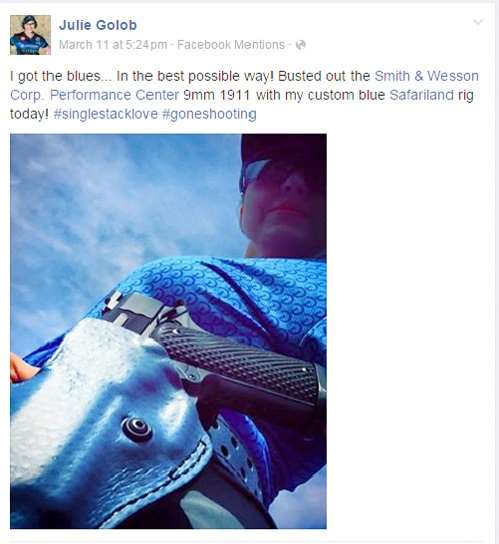
With terms like “live streaming” now entering the lexicon of even the oldest and crotchetiest shooters, (Hint: Google “Periscope”), the time is now to examine this amazing phenomenon, and we thought who better than Julie Golob to tell us how the platform has evolved from a competitive shooting standpoint.
Julie uses more than just Facebook and Twitter to communicate with her fans. Julie’s website also hosts her very own video channel called JulieG.TV (Check it out if you haven’t already. It is a real treasure trove of shooting info.) and serves up weekly podcasts. She even hosts a video series with Shooting Sports USA’s sister publication NRA Family with interesting topics such as “What to Expect When You Are Expecting for Concealed Carry” and “How to Talk to Young Kids About Guns.”
SSUSA: Tell us how you first started using social media?
Julie Golob: I discovered this thing called Facebook [Laughs], and so I jumped on and started connecting with shooter friends that I only got to see at matches like the Bianchi Cup and USPSA Nationals. It was a really fun way to connect beyond the few times in person throughout the year.
When Facebook rolled out the athlete page option, I thought it would be a great way to reach more people. I may have been one of the first, if not the first, competitive shooter to take advantage of it. Initially I got a lot of flak for it. [Laughs].
SSUSA: Really? That is surprising.
JG: A little bit. Back when social media was starting to really take off there were those that viewed having a Facebook page as self-promoting and it was looked down by some. I didn’t create it for that reason. I use my page as a tool to share shooting with people who I am not “friends” with on Facebook. I can connect with them through the athlete page and save my profile for personal posts. It wasn’t long before other shooters saw that it has a lot of value, and now just about everybody has a page. I think Facebook is a really great option for gun owners in general to connect.
SSUSA: A great tool to share a common love of the shooting sports?
JG: Sure. With Facebook you can make that “I love me” page like the Kardashians have—but the vast majority of shooters out there use it to connect with other gun owners and enthusiasts. It allows followers to get a “snapshot” of what life as someone who loves shooting and the shooting sports is really like—it’s a valuable tool.
SSUSA: What is your favorite social media network right now?
JG: Professionally? By far, Facebook. It has kept up with the demand by constantly innovating the platform. In the beginning it seemed like they were coming up with an update every three months, changing the newsfeed around and confusing people, but they have slowed down with the drastic changes. Facebook has incorporated some really cool tools and the apps are much more advanced over the other networks. Facebook is constantly evolving, and has proven to have staying power over the years too.
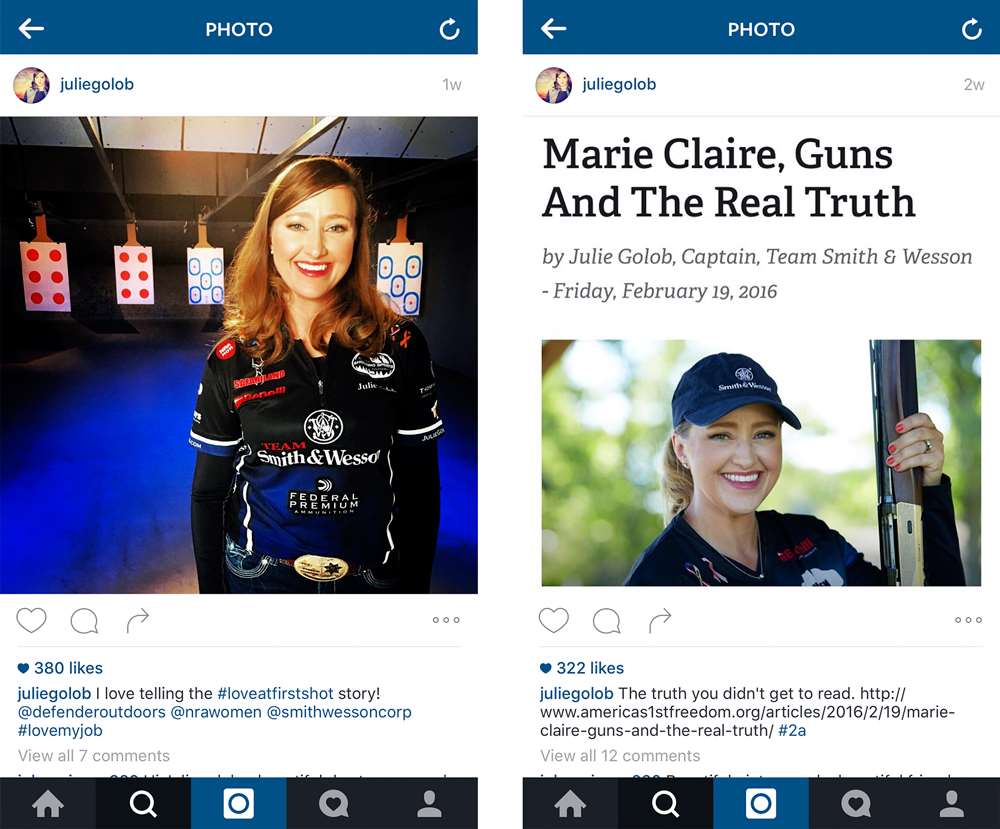
A close second and personal favorite of mine is Instagram. I love photos, both taking them and seeing others’, even if they are just pics that show a peek into people’s lives. I can follow all of my chicken pages [Editor’s Note: Julie loves chickens]. It’s a really neat way to find a niche of what you like, follow, and see what other people are doing.
SSUSA: Have you ever tried Vine or any of the newer services?
JG: I try them all, and I give them a trial period. Vine did not really click for me. I still have a username out there, but I no longer actively participate. My advice to shooters who think they need to be everywhere, is to slow down and find the outlets that you enjoy. If you dread social media and the processes involved with it, it will show and your fans will notice. The best route is to go with the service or networks that you enjoy using the most, and where you’ll happily spend your time and effort.
SSUSA: Do you think that live streaming services from Periscope, and more recently Facebook will have an impact on championships such as the Bianchi Cup?
JG: Live streaming has huge potential for the shooting sports! You can put up live video for everything from a local match to the Bianchi Cup, and have it seen by so many people. When I post live video, my view stats are higher than just traditional video.
Periscope is another great tool. I love when I get that little “tweet” on my phone and I can see who is streaming live. I can watch now, or I can watch it later, but only for up to 24 hours. Periscope is really intriguing because it has such a shelf life. There is a sense of urgency to it.
I think live video tools are great, whether it’s Facebook, Periscope or even SnapChat—because we can do this from our phones, we can take any experience everywhere. You can even stream to Periscope from a GoPro now. The technology aspect is amazing.
SSUSA: Do you think that live streaming and social media might have an impact on training the next generation of competitive shooters?
JG: It’s a possibility. Trainers now have an opportunity to share quick tips. For example, some professional shooters take to Periscope while training on the range. Being able to share nuggets of information that a shooter of any skill level can learn from and hopefully have that “Oh I need to do that … now I understand” moment is a great way to market a class or course. Instead of just reading about guns, gear and training, potential students are learning and seeing it in real time.
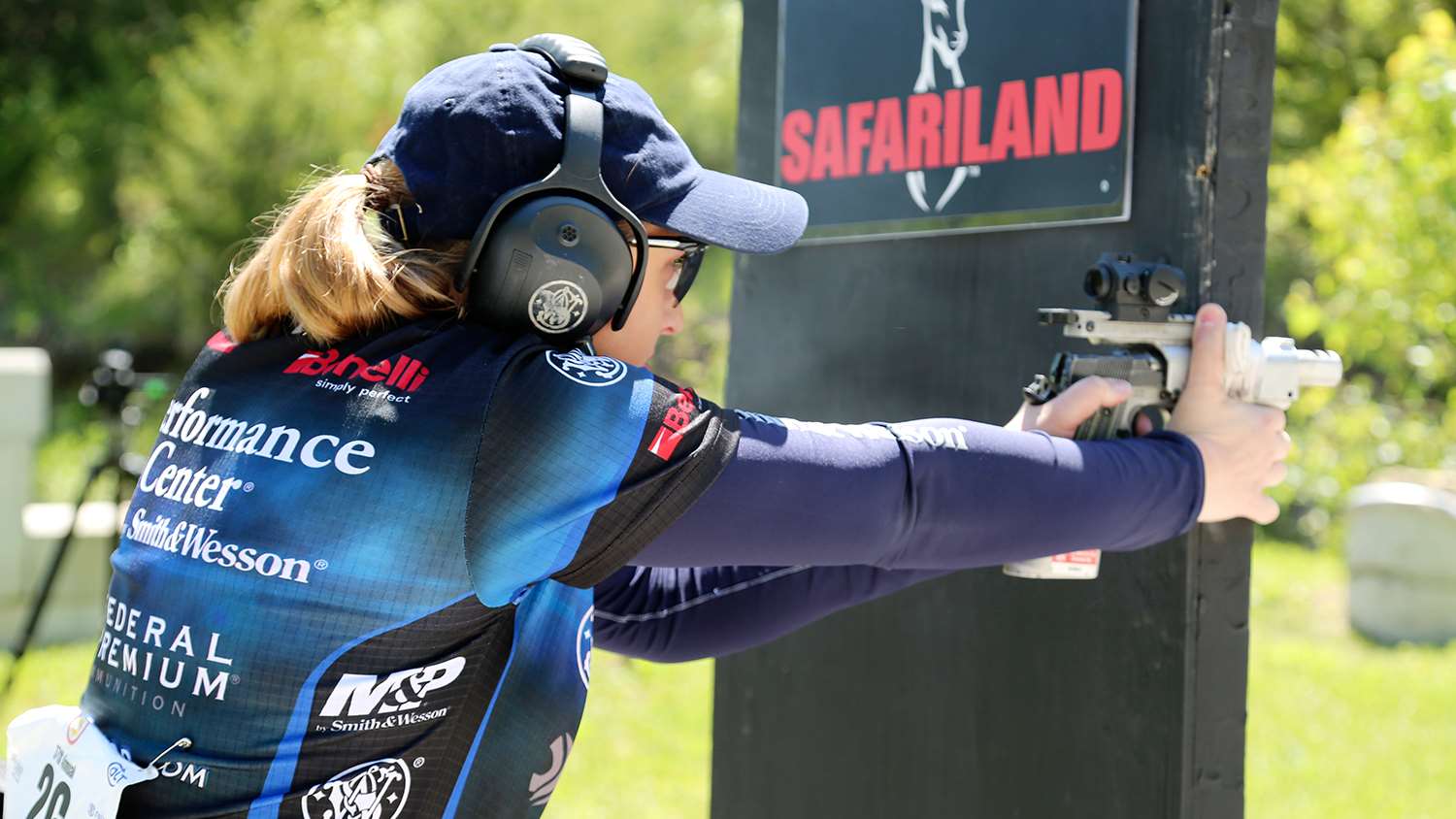
SSUSA: Do you think younger competitive shooters are interested in matches with more connectivity and instant gratification?
JG: I think there is an all-around interest for all of the different sports available in general. What social media and live streaming bring to the table is that the shooting sports are becoming accessible to this generation as soon as they are interested in it, and that is the key.
Gone are the days when a junior competitor, or even a millennial, will go and find a print magazine for the info they want. They are going to search YouTube or Google it first. If they are on a live streaming platform, or even Facebook or Instagram, and they can get information about an event, it’s going to inspire them. We want them inspired so they will go give the shooting sports a try, or at least think about gun safety and safe, responsible gun ownership.
It all comes full circle and frankly the shooting sports in general need to step up with the times. That goes for the shooting industry in general too. We need to be able to use these free communication tools, while they are still relatively unregulated and inexpensive, to connect the dots between new shooters, experienced shooters and our industry.
SSUSA: Do you see any differences in how you began your shooting career, and how junior shooters these days are starting theirs?
JG: Yes and no. I think the vast majority of new competitors out there are still learning from their families, in many cases it’s the dads—I was a daddy’s girl. Shooting is a great bonding hobby for dads and daughters, dads and sons, and of course, many moms and their kids too! That seems to be the common thread we see from the past, when I started shooting and shooters starting out now.
Nowadays, we are much more open to sharing the experience, versus how it was when I first started shooting. It was 25 years ago this year that I started competing, and I know when I first showed up at the range I was pretty much the only young girl around. I felt a good bit of scrutiny, this being during the Clinton Administration and a very anti-gun era for our country. Some people did not think my presence at the range was a good thing. That was the sentiment, until I was able to show that I was at the range because I wanted to be there, and I wanted to be safe, which was the most important thing. Shooters accepted me with open arms, almost like family.
Now, we are very proactive as an industry in general in supporting junior competitions and youth programs. We celebrate when young shooters are enjoying the shooting sports and being safe and responsible. It’s a stark contrast.
We also have all these kids sharing their experiences now, in a way that I felt I never could. For me, it was almost like "Fight Club," nobody talked about me shooting guns as a kid. [Laughs].
SSUSA: At what point going to the range as a youth did you know that shooting was what you wanted to do as a living?
JG: I am the middle child in our family, and I never really got along with my brother and sister as a kid. I didn’t want to hang around them, and I knew if I went to the range with my dad I would get a Happy Meal and do my own thing. It was great!
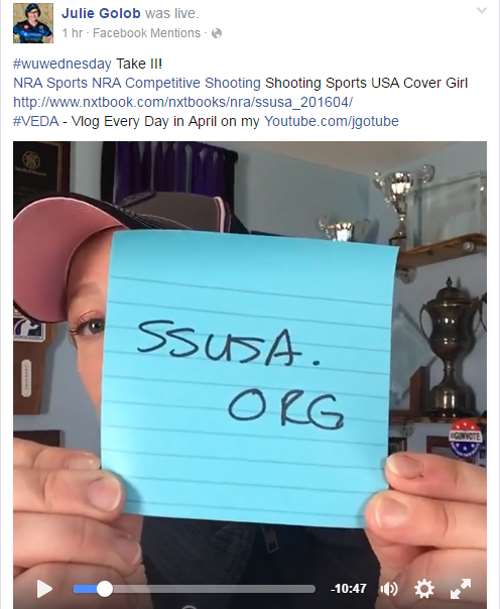
Then, I started helping shooters pick up their brass. My dad shot a lot of silhouette, so I began spotting for him, sitting behind the spotting scope, letting him know where he hit on the chickens, pigs, turkeys, and rams. It was fun, and my dad and I became a team. After that he started taking me to the action shooting events and that’s where I really became inspired.
Every year our home club hosted one of the largest matches in the country called the Miller Invitational. The pro shooters that attended, the Rob and Kippi Leathams, the Jerry and Kay Miculeks, etc. they became my athletic inspiration. When I was 14, my dad and I decided that I was old enough, responsible enough, and strong enough to give shooting a try. I remember driving home after one of those Miller Invitationals and I told my dad I wanted to be a pro shooter. It is something I set my mind to, and I knew I was going to do everything I could to do it.
SSUSA: Do you think that the social media demands these days facing pro shooters distracts from focusing?
JG: I think that if you are not social media savvy, it becomes challenging. A lot of pro shooters like to keep their lives private, because they don’t want a lot of their personal information out there or their “secrets to success” leaked out, because they work so hard to get where they are. Some pro shooters use social media as a tool to share their success and promote their sponsors. Other shooters have come onto the scene and because of their communication skills beyond the range have become pros because of social media.
Different companies see different value in both of these examples. Some companies think it doesn’t matter if they sponsor a “quiet” shooter, as long as that shooter brings home the titles. Contrast that with another company that may not even care if a shooter ever wins a single match, and companies like this want that personable presence. A shooter that is relatable to the shooting community becomes a great representative for their brand. In the end it all comes down to what a company wants for their brand.
The definition of a professional shooter is evolving. It used to be if you made a living based on your shooting performance, you reached pro status. Now there are other ways to shoot for a living and be considered a pro.
For me social media can be difficult because the more I do with social media, the more time I have plans to commit to it. I’m not going to be on social media and not be social. If someone takes the time to comment on my Facebook page, I’m going to read, like and possibly respond. Regrettably, I do miss some, but I really try to connect with those who connect with me. That’s very important to me. So yes, social media can be distracting, but it just takes time management and it’s extremely valuable communication with fellow shooters and followers.
SSUSA: I saw you recently crossed over 100,000 Facebook followers, congratulations! Quite the milestone. It must be very satisfying.
JG: Thank you! It is, very much. It’s completely 100 percent organic [self-found] too, and that’s what makes me most proud. That and the number of people I reach in the week. It’s significant, and I feel like what I’m doing is good for the world of shooting.
SSUSA: Julie, you definitely are doing very good things for the industry! Let’s talk about the upcoming championship season. What is your training regimen for the Bianchi Cup this year?
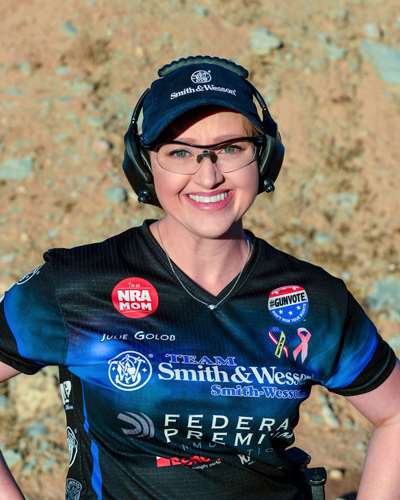
JG: Well with the NRA Annual Meeting the weekend before the Bianchi Cup it will be a tight schedule. Most U.S. shooters head to Columbia the weekend before, shooting 1000 rounds a day, each day, leading up to Bianchi. We do that because there are so many matches now, and so many divisions to compete in.
It will be very interesting to see who is specializing and how they are specializing leading up to Bianchi this year with the change in scheduling format. It’s going to be pretty intense for those lucky souls in the top brackets to shoot the match all over again. Not only do you have less time, but if you represent companies you most likely will be at the NRA Annual Meeting. That is where we meet with the grass roots.
This year I’m going to do something I’ve never done before in preparation for Bianchi. I usually cram Bianchi training right before the match. Usually in the weeks prior to the Cup is when I pull out the Bianchi guns and focus on action pistol. This year, I’m going to dedicate at least one day a week to shooting Bianchi leading up to the match. I want to build a foundation of being ready, well in advance. Not only do I have to prep for Bianchi, I also have the USPSA Single Stack and Revolver Nationals too.
There’s also an NRA Action Pistol regional in Kansas City, my hometown, on the Sunday of the NRA Annual Meeting weekend. I’m pondering the idea of driving to Louisville, driving back, shooting the regional, then driving to Columbia and getting ready for the Bianchi Cup. We’ll see! One thing is for certain, I’ll be sharing much of it on social media.
Thanks to Julie Golob for taking time out of her busy day to talk to Shooting Sports USA. Visit her website at www.juliegolob.com.














